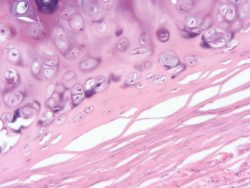 Research from the Univ. of Southampton has invented a novel way to use stem cells to generate tissue from human cartilage. This new technique could open up pathways for developing a much needed treatment for cartilage damage in people.
Research from the Univ. of Southampton has invented a novel way to use stem cells to generate tissue from human cartilage. This new technique could open up pathways for developing a much needed treatment for cartilage damage in people.
Cartilage serves as a shock buffer for the joints, however it is vulnerable to joint damage through trauma from falls or sports injuries or just daily wear and tear. The current surgical approach is to restore damaged cartilage regions utilizing cartilage cells but this has not been successful so far. This is due to the fact that survival of the cartilage tissue repair, which is caused by cartilage type cells at the damage site, has been shown to decrease just 5 to 10 years after the repair. There is a vital requirement for a new way to encourage long-term, robust repair through cartilage tissue implantation rather than to cartilage cells at the location of the damage.
Researchers believe they have discovered the answer to the dilemma. They generated tissue from cartilage in the lab through the success of transforming embryonic stem cells to cartilage cells. They then utilized these cells to generate 3-dimensional pieces of tissue from cartilage without using any natural or synthetic supporting substances. This is known as a cartilage engineering technique that is scaffold free. This new generated cartilage tissue produced is mechanically and structurally comparable to normal human cartilage and has the potential for a long lasting and stable repair that isn’t currently available to people.
The researchers for the study were the initial team to use this scaffold-free engineering technique to produce cartilage tissue which has been scaled up 1 mm with no adverse affects to its mechanical and structural properties. They hope that eventually following more research, the laboratory created tissue could routinely be used in surgery to heal damaged cartilage.
The research is exciting because the team’s ability to generate cartilage with properties similar to normal human cartilage will have the potential to provide vigorous tissue that has been engineered for repair of damaged cartilage.
The team thinks this tissue based approach of replacing like-for-like cartilage has the ability to form a step-by-step change improvement in the current cell based surgeries for the repair of damaged cartilage and improve the patient’s long term future and outcomes from the cartilage repairs.
To view the original scientific study click below:
A scaffold-free approach to cartilage tissue generation using human embryonic stem cells





